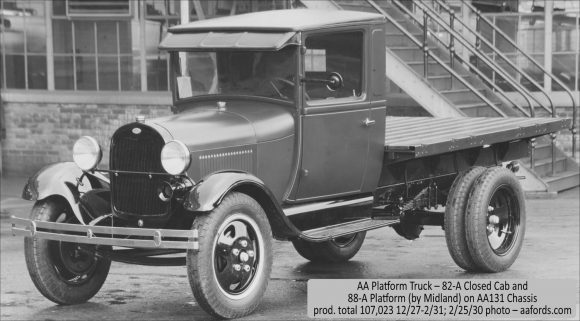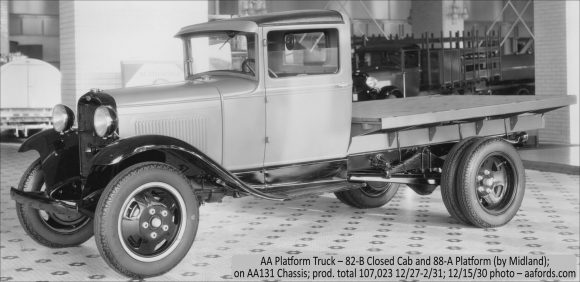2023/11/30 update
88-A Platform Pages
| Platform Bodies and Equipment | Production Dates-Counts | Supplier | ||
|---|---|---|---|---|
| Start End | Count | Total*1 | ||
| Neil Wilson 2023 | ||||
| Platform without equipment | 12/27 02/31 | 21,535 | 107,023 | Midland |
| 88-A with 134-A Stock Racks | 02/29 12/29 | 781 | unknown | |
| 88-A with 134-B Grain Sides | 02/29 11/29 | 481 | unknown | |
| 88-A with 188-A Stake Racks | 12/27 02/31 | 84,226 | Midland | |
| *1 – 1927 counts added: 88-A = 12, 88-A with 188-A = 120 | see..FMC ART Adj. | |||
February 1930 and December 1930 assembly line AA platform trucks are shown above. Both have the 88-A platform. The 82-A closed cab was used into June 1930. The 82-B closed cab was used starting in June 1930.
This “Midland Steel Products Company” supplied platform cargo body was sold by Ford for their production of platform, stake, stock, and grain trucks on the 131-1/2” wheel base AA-chassis. The 88-A platform was use from the start of AA production in December 1927 thru February 1931. In March 1931 a larger platform (type 187-A) was put into production. The 88-A platform is subdivided as three designs for this article. The usage dates and key identification features are indicated for each design.
Within each design there were additional part changes which are identified in the 88-A Details page.
d1 (1927—2/28) – 4 side stake pockets and 3 external rear stake pockets, rear “Ford Truck” stamping, 1-1/8″ angles.
d2 (3/28—mid-28) – 6 side stake pockets and 3 external rear stake pockets, rear “Ford Truck” stamping, 3-9/16″ angles. There were d2a and d2b designs:
d2a (3/28) – Cross sill 3 and 4 did not have fender cutouts and there were no fender braces.
d2b (mid-1928) – Cross sill 3 and 4 had fender cutouts and there were fender braces.
d3 (mid-28—2/31) – 6 side stake pockets and 4 external rear stake pockets, no rear stamping, 3-9/16″ angles. There were d3a and d3b designs:
d3a (mid-1928—mid-1929) – There were fender braces.
d3b (mid-1929—2/31) – There were no fender braces.
The 88-A platform consisted of nine 1-1/4” thick floor boards with skid strips which were used to bolt the boards to a stamped steel support structure. This structure was attached to wooden floor side sills using angles. The body was installed on the frame with U-bolts (plus brackets starting in August 1928).
This platform was a modified 1927 TT platform. Some of the TT platform parts were direct carry-overs. The major difference between the 88-A and TT platforms was the side sills. For the 88-A the side sills were wider apart at the rear (i.e. tapered front to rear) to allow the body to rest on the AA frame which was also tapered. Additionally, the side sills were solid wood, unlike the TT which had “C” shaped steel sills lined with wood.
Excluding front and rear external stake pockets, the overall body dimensions were 73-1/4” wide by 99-1/8” long. It was 12-7/8” from the bottom of the side sills to the top of the cargo floor boards. With stake racks, stock racks, or grain sides installed, the usable cargo floor was 68” wide by 97-1/2” long. The platform truck’s spare wheel carrier was located under the rear of the body. There were three wheel carrier designs used during the 88-A platform’s production period.
This platform weighed 469 lbs. with wheel carrier. A complete truck with platform and closed cab on the 1928/1929 AA-chassis was 3,172 lbs. (included 5 wheels, 4 tires, tools, and the optional dual high transmission).
The platform was completely assembled before being painting the same color as the cab. Consequently, the body was painted as a unit, including floor boards and fasteners.
The 88-A platform was designed to set on the AA-chassis frame which was wider at the rear than at the back of the cab (i.e. a tapered design). Several versions of installation hardware were used to attach the platform to the frame.
These hardware versions included U-bolt setups and body-sill-to-frame brackets. Also AA-chassis parts were used which included frame-spacers, and body stops or frame-to-body sill brackets.
Ford supplied optional equipment for the 88-A platform was the 134-A – Stock Racks, 134-B – Grain Sides and 188-A – Stake Racks.


